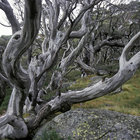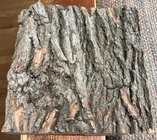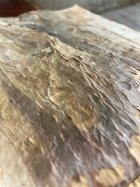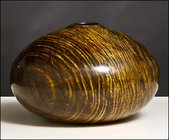Is there a way to determine if a tree has figured wood before it is cut into woodturning blanks? Are there any telltale signs?
-
November 2025 Turning Challenge: Wall Hanging! (click here for details) -
Sign up for the 2025 AAW Forum Holiday Swap by Monday, November 24th (click here for details) -
Congratulations to Tracey Lee for "Huggins with Rope" being selected as Turning of the Week for November 10, 2025 (click here for details) -
Welcome new registering member. Your username must be your real First and Last name (for example: John Doe). "Screen names" and "handles" are not allowed and your registration will be deleted if you don't use your real name. Also, do not use all caps nor all lower case.
You are using an out of date browser. It may not display this or other websites correctly.
You should upgrade or use an alternative browser.
You should upgrade or use an alternative browser.
Finding figured wood
- Thread starter Jeff Scott
- Start date
- Joined
- Jul 18, 2018
- Messages
- 1,314
- Likes
- 2,828
- Location
- Baltimore, MD
- Website
- loujacobswoodturning.com
Here’s a link to a Richard Raffan video that addresses this. Crotch wood usually has attractive figure in it also.
View: https://youtu.be/CUWlwOC1-OA
Crotches are a definite source and the compression wood under a large branch.
The compression wood is usually due to how a branch develops as in when a branch is small it will likely reach for the sun at a steep angle but as it gets older/bigger it also gets heavier and then can end up at a not so steep angle. The compression wood often will show as horizontal ribs even in the bark.
The compression wood is usually due to how a branch develops as in when a branch is small it will likely reach for the sun at a steep angle but as it gets older/bigger it also gets heavier and then can end up at a not so steep angle. The compression wood often will show as horizontal ribs even in the bark.
Simple answer - no. Until you cut it up you won't know what you have and sometimes you don't know until you rough out what your turning. Everytime I get a log it's Christmas morning. Mother nature has given me a present in the log. I don't know what it is yet. I just hope it;s not underwear from Grandma.
Thanks! That's helpful. I don't know what kind of tree is in your attached picture, but I've never seen one growing in Oklahoma!What I look for is trees that have a smooth bark finish, you can see the ripples in the bark, especially under large branches where they attach to the main trunk. In the foreground of the image you can see the beginning quilting
I have always felt the same way about the mystery of what the wood will look like, which is probably why I asked the question. I liked your Christmas morning analogy. Every time I get a new log, it reminds me of being a kid, and opening a new pack of baseball cards. I always hoped I would find a card of Mickey Mantle or Willie Mays, but sometimes I just found Gus Zernial or Bob Turley!Simple answer - no. Until you cut it up you won't know what you have and sometimes you don't know until you rough out what your turning. Everytime I get a log it's Christmas morning. Mother nature has given me a present in the log. I don't know what it is yet. I just hope it;s not underwear from Grandma.
˙Hackberry, with warts on its leaves and no fall color, is the biggest surprise of all. For all its ugliness as a tree, it has beautiful grain. I'm no preacher, but my wife tells me that you could use the wonder of hackberry for the theme of a great sermon!
@Jeff, bodark (horse apple tree) has some nice figure and you should be able to find it there. Pecan can have some lovely grain too. Bradford Pear. There are prepping techniques that can enhance the grain and show off the figure in the wood better. If you search the site you should be able to find several threads about how to cut logs, prep blanks for accenting the grain.
Well, some times you can tell. Some times you can't. I got one branch from a big leaf maple a few years back. It was growing horizontally. About 18 inches high, and maybe 10 inches wide. The pith was in the upper 1/3 of the log. That was rippled all through the whole log. When growing sideways like that, the fiber has to do the accordion thing so the branch can bounce up and down when windy because straight fiber would break. Pretty much any tree that is leaning will have this type of figure, more so if it is in a windy location, and the more it leans, the more figure it will have. Same with crotch wood. If it is in a windy place, then lots of figure. Got a big black walnut once that was deep down in a valley. 20 inch limbs coming into the crotch, and no feathering at all. Also, the bottom buttress part of the tree will usually be figured since it supports the sideways movements of the tree as the wind blows. Some trees are genetically prone to figure. Saw a black walnut once that had heavy ripple through out the entire tree. I only got some cut offs. Kind of the same with birds eye maple. Apparently the only common trait of most of them are that they are 'distressed' trees. Some times you only find out after you cut them. There is a beech tree on the U of O campus that the landscapers call the 'elephant's leg'. You can see all the ripple in the base. It was at least 30 inch diameter 50 years ago when I was on the campus....
robo hippy
robo hippy
As I understand it, it is possible to tell what figure a maple tree will have--birdseye, quilting, etc. Guys who harvest the trees in New England and cruise the forests and note trees that will have the valuable figure.
Me, I'm Forest Gump with a box of chocolates like the rest of you. "You never know what you're going to get."
Me, I'm Forest Gump with a box of chocolates like the rest of you. "You never know what you're going to get."
Determine, rather rather than able to tell/see, yes you can, experience helps a lot of where to expect figured wood, but sometimes it is hard to see, even in straight growing trees I have found you can find figured wood, had a large and thick (over 3 feet D) short stem Silver Maple and the stem was totally figured wood, and you could tell on the barkIs there a way to determine if a tree has figured wood before it is cut into woodturning blanks? Are there any telltale signs?
Then there is places in a tree that tend to have figure, like was mentioned under large limbs, the stress and weight will cause ripple in that area, the very base of larger trees, and yes under the crotch IF it is not a narrow crotch, narrow steep crotch fail to grow together and so that feather grain will not develop.
Looking at the bark you can sometimes tell that there is figured wood in there, and it also sometimes shows ripple, you do have too see if something is off, and that can also be just bad wood overgrown damage etc.
Live and learn and yes it can be Christmas morning
.


Last edited:
Jeff I 'm in Australia and many of the Eucalyptus trees have very smooth bark/skin with that its very easy to see the stress lines that make up quilting. A while back I was given a large Redgum stump 1.5m dia [5ft] the quilting was clearly evident as I walked around it.Thanks! That's helpful. I don't know what kind of tree is in your attached picture, but I've never seen one growing in Oklahoma!
I strongly disagree. You just haven't seen a highly figured tree if you don't think the bark doesn't mimic the figure. In the first picture you see an abrupt stop in the vertical lines of the bark and a cluster of bumps in the lower left section. The next picture of the inside of the bark shows the bumps and craters from this section that were in the figured maple. It's very easy to see compression figure in the buttress knees and under major limbs. The third picture was from a rippled buttress knee. You could see that figure 50 yards away. The center of that hollow form was parallel to the ground and the knee was only about 1" wider than the vessel is tall.Simple answer - no. Until you cut it up you won't know what you have and sometimes you don't know until you rough out what your turning. Everytime I get a log it's Christmas morning. Mother nature has given me a present in the log. I don't know what it is yet. I just hope it;s not underwear from Grandma.
Attachments
- Joined
- Apr 27, 2004
- Messages
- 9,296
- Likes
- 6,048
- Location
- Lakeland, Florida
- Website
- www.hockenberywoodturning.com
Crotches are most common figure - all trees have crotches
One thing I learned from Al Stirt is that stitching pattern on the bark usually indicates a bark inclusion.
Bad bark inclusions mean a worthless blank.

At 100% your correct but sawmill workers can spot curly maple and birdseye with very high accuracy
My experiences with crotches is I know of no way to predict the thickness of the crotch figue.
Mostly it is shallower than an inch but we had a big box elder that showed a lot of feather on a 4” thick slab.
I can sometimes spot curl in maple. Most show cross lines near the roots
way to determine if a tree has figured wood before it is cut into woodturning blanks
One thing I learned from Al Stirt is that stitching pattern on the bark usually indicates a bark inclusion.
Bad bark inclusions mean a worthless blank.

.Simple answer - no. Until you cut it up you won't know what you have and sometimes you don't know until you rough out what your turning.
At 100% your correct but sawmill workers can spot curly maple and birdseye with very high accuracy
My experiences with crotches is I know of no way to predict the thickness of the crotch figue.
Mostly it is shallower than an inch but we had a big box elder that showed a lot of feather on a 4” thick slab.
We have red gum eucalyptus and if I see cross lines in the bark I know it will have great figure.just haven't seen a highly figured tree if you don't think the bark doesn't mimic the figure.
I can sometimes spot curl in maple. Most show cross lines near the roots
Thanks to everyone! I asked a fairly elementary question, and within 24 hours I received 10 replies that were straight to the point, not the least condescending, and extremely helpful.
This is the 2nd or 3rd question I have asked the forum, and every time I have been blown away by the attitude and knowledge of the forum members who have replied! This is such a valuable resource!
Now, I have another question. It's clear from your replies that the wood at, or below a crotch, is likely the location for figured wood. So, what is the safest way to slice (resaw) the wood at a crotch? It is where the trunk meets a major limb, so it is hard to secure it for a chainsaw or a bandsaw. Once again, your advice would be appreciated!
This is the 2nd or 3rd question I have asked the forum, and every time I have been blown away by the attitude and knowledge of the forum members who have replied! This is such a valuable resource!
Now, I have another question. It's clear from your replies that the wood at, or below a crotch, is likely the location for figured wood. So, what is the safest way to slice (resaw) the wood at a crotch? It is where the trunk meets a major limb, so it is hard to secure it for a chainsaw or a bandsaw. Once again, your advice would be appreciated!
- Joined
- Apr 27, 2004
- Messages
- 9,296
- Likes
- 6,048
- Location
- Lakeland, Florida
- Website
- www.hockenberywoodturning.com
Now, I have another question. It's clear from your replies that the wood at, or below a crotch, is likely the location for figured wood. So, what is the safest way to slice (resaw) the wood at a crotch? It is where the trunk meets a major limb, so it is hard to secure it for a chainsaw or a bandsaw. Once again, your advice would be appreciated!
Safest - ?? - depends on being competent with a chainsaw.
All saws can produce serious injuries or death. Chainsaws are quite safe when used properly.
If you know how to use a chainsaw you understand this part.
If you don’t take a course or work with a club member you trust.
Check out a thread I started on
Cutting a crotch in half
I am often asked how to cut blanks from crotches. The way I do it is to employ a low tech custom made " log processing station" This is a log section with a notch. The notch needs to hold the crotch. I set the crotch in the notch so that the centers of the two centers on...
Also if you want to try a heart shaped bowl this thread will show how I do it.
Naural edge bowl from a crotch
Turning a crotch is fun and produces a heart shaped bowl with a highly figured bottom. I put a video from a demo I did in may on YouTube. These are nice bowls for turners who have done 4-5 natural edge bowls without getting a catch. While best suited for intermediate and advanced beginners...
Crotches make excellent platters.




